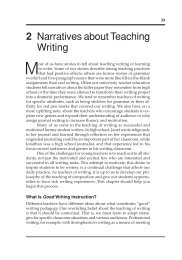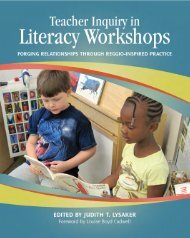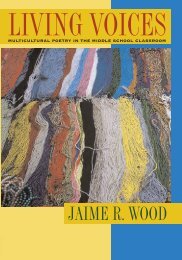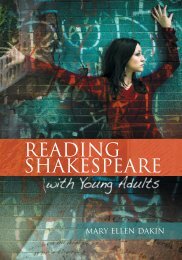Graphic novel Spread - National Council of Teachers of English
Graphic novel Spread - National Council of Teachers of English
Graphic novel Spread - National Council of Teachers of English
- No tags were found...
Create successful ePaper yourself
Turn your PDF publications into a flip-book with our unique Google optimized e-Paper software.
Introduction—Carving a Niche 5<br />
ics, Inc., illustrates the role <strong>of</strong> sequential art in enriching educational<br />
experiences. Whereas others have successfully shown the appeal and<br />
interest to younger students <strong>of</strong> comics during the school day (Dyson,<br />
1997), Bitz worked with older students as well and in after-school sites.<br />
The project was designed “as a way <strong>of</strong> putting into practice some <strong>of</strong> the<br />
most important educational research <strong>of</strong> the last decade—that is, the<br />
correlation between involvement in the arts and performance in academic<br />
subjects,” namely, the Fiske and Deasy studies (Bitz, 2004, p.33).<br />
Bitz also drew from other studies demonstrating “that children discover<br />
meaningful dimensions <strong>of</strong> their worlds when they can explore them<br />
through creative arts, including comic books” (Bitz, p. 575). In the fall<br />
<strong>of</strong> 2002, “733 children at 33 after-school sites in New York city brainstormed,<br />
outlined, sketched, wrote, and designed original comic books”<br />
(p. 574). The goal was “to build literacy and artistic skills while motivating<br />
children not only to attend the sessions but also to take ownership<br />
<strong>of</strong> and pride in their work” (p. 575). Guided by specially trained<br />
instructors, students from grades 4–8 (Bitz now has worked with high<br />
schoolers as well) used pr<strong>of</strong>essionally created templates to create sequential<br />
narratives in which words and images were in every panel (p.<br />
577) and engaged in workshop activities designed for sharing and critiquing<br />
with the aim <strong>of</strong> completing and “publishing” their own eightpage<br />
comics (p. 578–79). Bitz reports that, although many students were<br />
familiar with the superhero theme in comics, most <strong>of</strong> their own personal<br />
sequential narratives “were based on the hard reality <strong>of</strong> living in an<br />
inner-city environment” (p. 580). Based on surveys distributed to instructors<br />
and students, Bitz also found the following:<br />
Eighty-six percent <strong>of</strong> students felt the project helped them improve<br />
their writing.<br />
Ninety-two percent said they liked their own stories as a result<br />
<strong>of</strong> the project.<br />
Eighty-eight percent said they look to pictures for clues in stories<br />
because <strong>of</strong> the project.<br />
Ninety percent <strong>of</strong> instructors felt that their students’ writing<br />
was improving.<br />
Ninety percent <strong>of</strong> instructors felt that, as a result <strong>of</strong> the project,<br />
their students like to write their own stories. (p. 582).<br />
Open-ended questions solicited comments such as “This was the first<br />
time I got my kids to write without complaining about it” and “Living<br />
in the city, these children see a lot <strong>of</strong> things that aren’t so positive. A<br />
project like this gives them the chance to express what’s happening
















